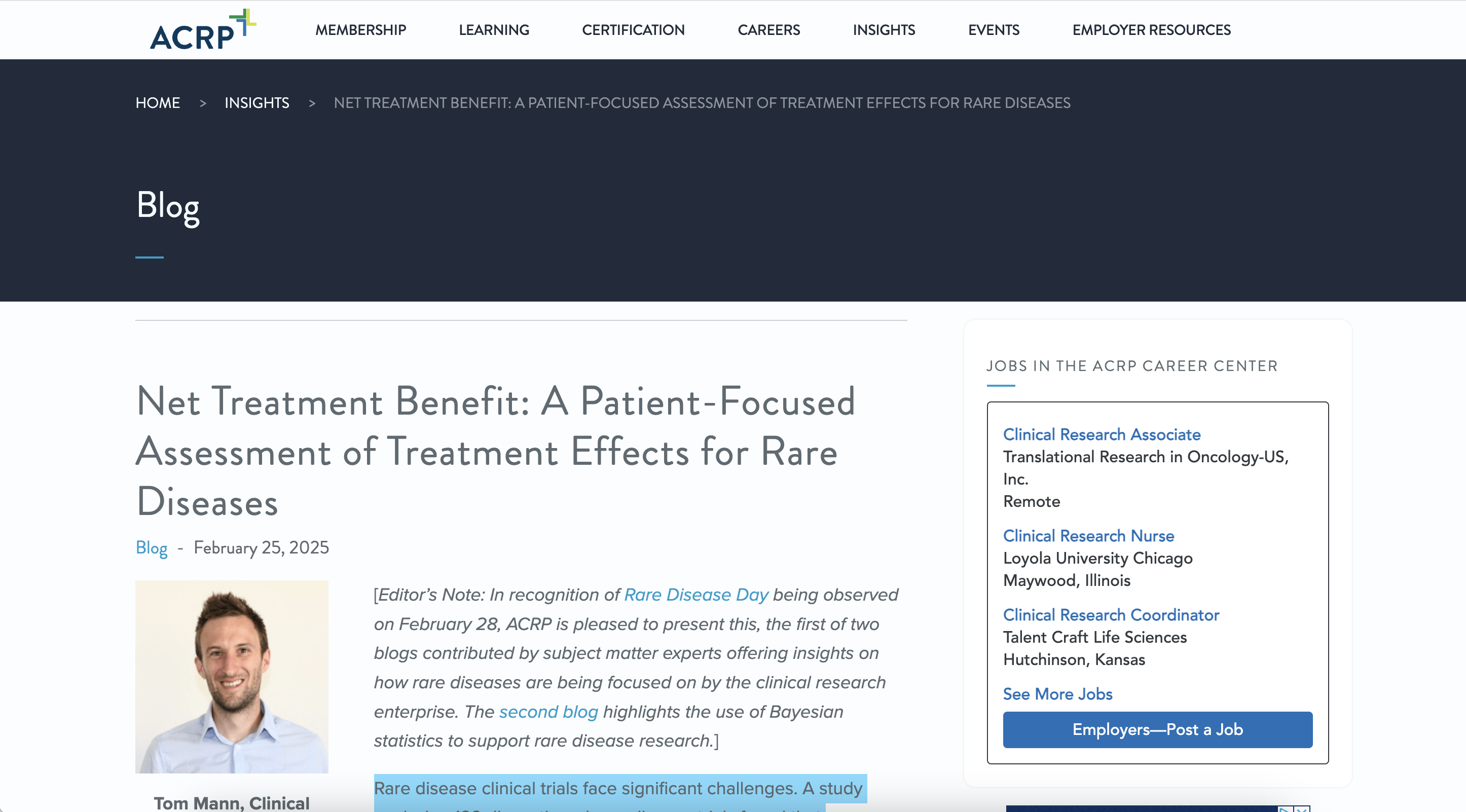
Net Treatment Benefit: A Patient-Focused Assessment of Treatment Effects for Rare Diseases
BackThis blog was originally published by the Association of Clinical Research Professionals (ACRP).
Rare disease clinical trials face significant challenges. A study analyzing 199 discontinued rare disease trials found that insufficient patient accrual was the primary cause,¹ with up to 33% of trials failing due to this cause. With small patient populations, leveraging innovative statistical methodologies that can enhance statistical power is crucial. It enables the detection of treatment effects with a reduced sample size, making the study more feasible. Traditional clinical trials typically rely on a single primary endpoint, such as overall survival or disease progression. However, in rare diseases, multi-dimensional outcomes—including efficacy, safety, and quality of life—are often equally important.
The Net Treatment Benefit (NTB), estimated from the Generalized Pairwise Comparisons (GPC) methodology, provides a promising solution by integrating multiple clinical outcomes into a single assessment, extracting more information from the data.² This innovative approach allows for more powerful, patient-focused analyses, thus enabling smaller, faster, and more cost-effective trials without sacrificing scientific rigor.
The NTB is the difference between the probability that a random patient in the treatment group has a more favorable outcome than a random patient in the control group and the probability of the opposite occurring. By considering multiple endpoints within a single analysis, NTB provides a more comprehensive picture of a treatment’s overall benefit-risk profile. Unlike traditional methods, NTB enables prioritization of outcomes based on clinical importance and patient preferences, offering a more patient-focused approach to clinical trial analysis.
Reducing Sample Size in Rare Disease Trials
Since most clinical trials estimate treatment effects using a single outcome, they often require a large sample size to achieve statistical significance and demonstrate the treatment’s superiority. The NTB can improve statistical power by borrowing information from multiple outcomes, ranking them hierarchically, and allowing clinically meaningful thresholds to distinguish relevant differences.
This is especially beneficial for rare diseases, where patient recruitment is challenging, and every patient is invaluable. A reduced sample size means trials can be conducted more quickly and efficiently, which minimizes costs and allows promising new therapies to reach patients sooner. In the context of rare diseases, where treatment options are often limited, any method that speeds up research while maintaining robust statistical evaluation is a major advancement.
Specifically in the rare disease domain, a post-hoc analysis of the randomized, double-blind, Phase III COMET trial, prioritizing the primary (forced vital capacity) and secondary outcome (6MWT), provided evidence of efficacy of avalglucosidase alfa therapy (n = 51) over alglucosidase alfa (n = 49) in Pompe disease, while the original analysis failed to significantly show superiority of treatment on the primary endpoint.³
While no drug has been approved by regulatory bodies using the NTB for rare diseases, the methodology is widely used in other therapeutic areas and has been successfully included in regulatory submissions. Notably, it was used as the primary analysis in the Phase III ATTR-ACT trial, where the analysis prioritized time to death over time to hospitalization. Results demonstrated the efficacy of tafamidis (n = 264) over placebo (n = 177) and led to the drug approval for patients with transthyretin amyloid cardiomyopathy.⁴
Conclusion
The Net Treatment Benefit represents a transformative step in clinical trial design, particularly for rare diseases where smaller sample sizes are more common due to the limited patient populations. By incorporating multiple outcomes into a single, more comprehensive estimation, the NTB enables more efficient, transparent, and patient-focused trials. Unlike traditional methodologies, which often rely on a single endpoint for regulatory approval, NTB provides a more holistic assessment of treatment effects.
With growing regulatory support and clear advantages in reducing sample size, NTB has the potential to reshape the landscape of rare disease clinical trials, making them more feasible, cost-effective, and aligned with patient needs. As clinical research continues to evolve, adopting NTB-based approaches will be crucial in accelerating the development of new treatments and improving outcomes for patients with rare diseases.
References
- Rees CA, Pica N, Monuteaux MC, Bourgeois FT. 2019. Noncompletion and nonpublication of trials studying rare diseases: a cross-sectional analysis. PLoS Medicine 16(11):e1002966.
- Buyse M, Verbeeck J, Saad ED, Backer MD, Deltuvaite-Thomas V, Molenberghs G (Eds.). 2025. Handbook of Generalized Pairwise Comparisons: Methods for Patient-Centric Analysis (1st ed.). Chapman and Hall/CRC. https://doi.org/10.1201/9781003390855
- Verbeeck J, Dirani M, Bauer JW, Hilgers RD, Molenberghs G, Nabbout R. 2023. Composite endpoints, including patient reported outcomes, in rare diseases. Orphanet Journal of Rare Diseases 18(1) :262.
- Maurer MS, Schwartz JH, Gundapaneni B, Elliott PM, Merlini G, Waddington-Cruz M, … and Rapezzi C. 2018. Tafamidis treatment for patients with transthyretin amyloid cardiomyopathy. New England Journal of Medicine 379(11):1007–16.
Contributed by Tom Mann, Clinical Solutions Engagement Lead at One2Treat. Mann has more than 15 years of experience in technology start-ups and scale-ups in settings where he played a pivotal role in driving customer engagement, marketing initiatives, and strategic partnerships. At One2Treat, he helps develop solutions that integrate key patient-relevant outcomes into a single holistic treatment assessment, ensuring that the company’s approach remains both innovative and patient-focused.



